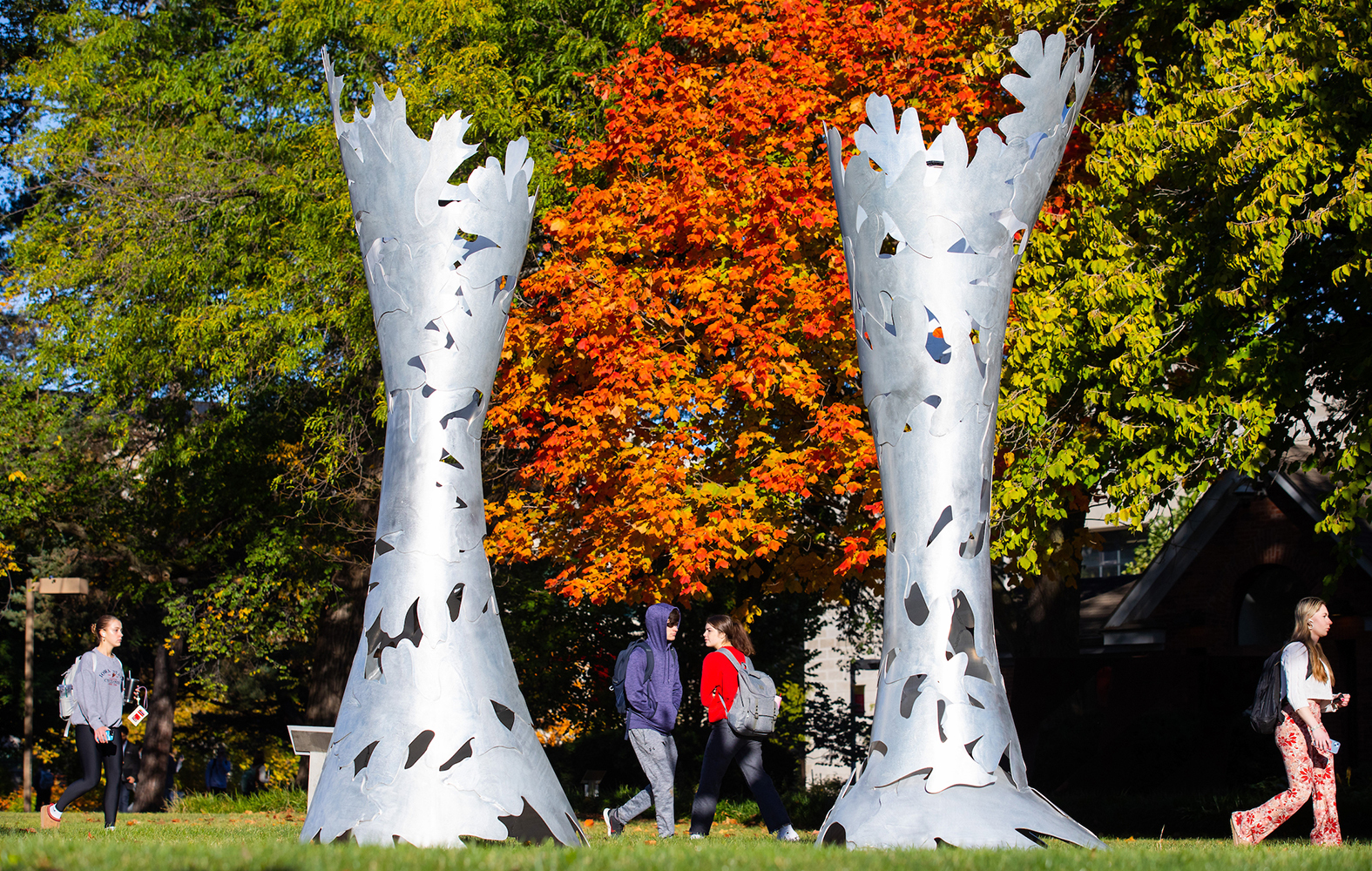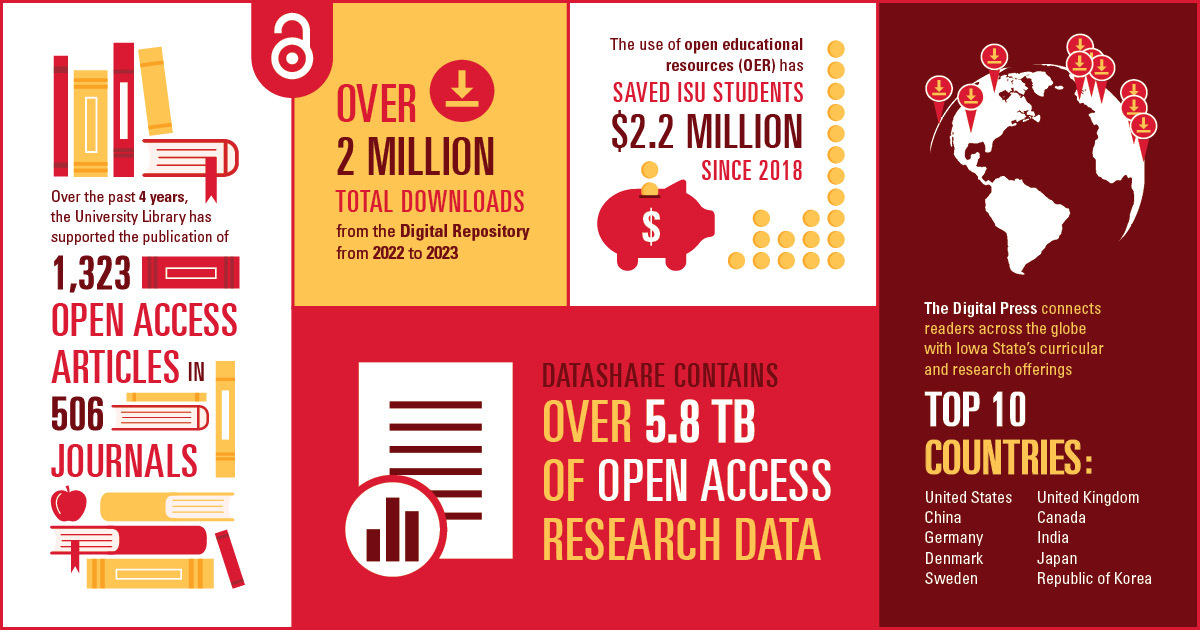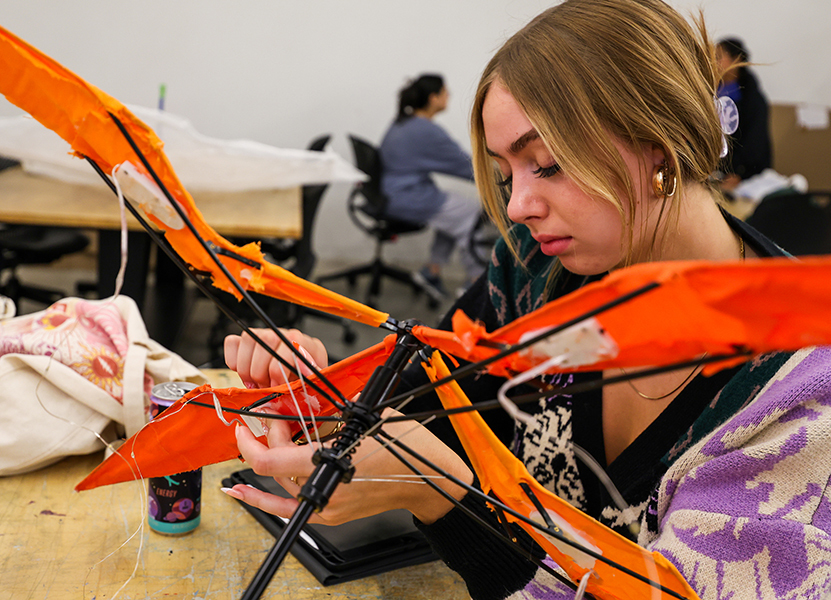Central campus trees

Photo by Christopher Gannon.
Students cross between a canopy of maple leaves and Iowa sculptor Tom Stancliffe's Ghost Trees, part of the Anderson Sculpture Garden between Beardshear and Morrill halls, on Tuesday morning. When it's dark, Stancliffe's trees are internally lit by solar-powered LED lights. The sculpture is on a two-year loan from the artist.
Work-life balance, student success are the priorities during winter session
Editor's note: On Nov. 2, university leaders announced that Gov. Kim Reynolds called for two additional paid holidays for state employees in recognition of their service during 2023. Iowa State will implement one of those holidays on Wednesday, Dec. 27.
Iowa State's fourth winter session (Monday, Dec. 18, through Friday, Jan. 12, 2024) fully occupies the four-week break between fall and spring semesters. Like its predecessors, winter session will be offered online, with courses selected for their usefulness to continuing undergraduates. Most students will not be in Ames, though they will have access to academic support and student services.
University human resources (UHR) leaders said a top priority during those four weeks is maintaining staff levels to support a successful winter session for enrolled students. They also noted that the lower activity level presents an opportunity for the university to reduce energy costs and employees to use accrued vacation hours and enjoy time away from their jobs.
Learn more
An FAQ for staffing during university breaks
UHR associate director Andrea Little, employee and labor relations, summarized winter break guidelines in an Oct. 6 memo to supervisors.
The compact winter session contains three university holidays, Dec. 25-26 and Jan. 1. Offices are closed and classes don't meet on those days.
If you're working
Units open during the winter break may implement break office hours (7:30 a.m.-4 p.m.) from Dec. 18 through Jan. 12, while still serving students and their other customers or clients. Units that provide operational services, critical maintenance or utilities services, or previously scheduled public service programs should continue to do so, Little said. Likewise, research programs that shouldn't be interrupted will continue their necessary operations.
It's expected that employees in units that are open will be "fully engaged" and performing their regular work responsibilities, she said.
Staffing guidance for university breaks provides more information.
If you're not working
Units should communicate with their building supervisor about building and office access, and they should share these decisions on their websites, door signs, voice messages, social media sites, etc. Little said supervisors are encouraged to support a work-life balance for their employees during the break period and accommodate vacation requests whenever possible. Employees may request unpaid leave, though they would be paid for any university holidays that fall during their unpaid leave period.
Senior leaders may approve requests to physically close offices the week of Dec. 25 for units that develop procedures to manage emergencies and incoming messages during their office closure. If employees use two vacation days (Dec. 28-29), with weekends and the three university holidays they could create a 10-day window away from work, Dec. 23 through Jan. 1.
Student employees may pick up more hours
The four-week winter break period is considered nonacademic so, if work is available for them, student employees may work more than the 20 hours/week cap they face during the academic semesters.
Semester break calendar
- Friday, Dec. 15, fall semester ends
- Friday-Saturday, Dec. 15-16, commencement ceremonies
- Monday, Dec. 18, online winter session begins
- Monday-Tuesday, Dec. 25-26, university holidays
- Wednesday, Dec. 27, additional paid holiday for all state employees
- Monday, Jan. 1, 2024, university holiday
- Friday, Jan. 12, online winter session ends
- Monday, Jan. 15, university holiday
- Tuesday, Jan. 16, spring semester begins
Course redesign benefits instructors and students
Helping instructors build engaging Canvas courses is the idea behind the Center for Excellence in Learning and Teaching's (CELT) Course Design Institute (CDI).
The institute takes place during the summer and winter sessions and provides instructors a redesign roadmap in Canvas aided by Quality Matters guidelines. Instructors work with the CELT instructional designers to focus on improvements around course content, learner interaction, instructional technology and accessibility.
Winter CDI
The winter session Course Design Institute begins in December. Interested instructors can apply from Oct. 26 to Nov. 15.
The outcome is well-organized courses where students can easily locate, engage with and complete coursework. Instructors also gain an understanding of how to plan a quality course with clear learning objectives.
"Often, it is about small improvements that take place over time," said CELT course design and quality senior manager Lesya Hassall. "The institute gives instructors time and room to build measurable learning objectives and to think about how their assessments and activities motivate the students."
The institute lasts about a month with the intention that the process continues beyond it. Courses -- in person and online -- are chosen for redesign either by instructors through a CDI application process or associate deans, who prioritize strategic courses in their colleges.
Structured redesign
CDI participation includes:
- Attendance at four online synchronous check-in sessions facilitated by accounting associate professor Christine Denison
- Completion of the asynchronous Canvas course
- Work with the assigned CELT instructional designers to redesign the course
- Completion of a Quality Matters self-review of their course to plan further improvements
Throughout CDI, instructors learn the basics of the backward and accessible course design process as they revisit their course content, activities, assessments and engagement strategies. Backward design starts by identifying the objectives before planning the course. After instructors complet each module in the CDI asynchronous Canvas course, they take a quiz and plan enhancements for their courses.
"This is a chance for instructors to walk in the students' shoes," said CELT instructional design manager Angi Karthik. "They're able to experience learning in the online course as students would."
CDI synchronous check-in sessions bring instructors together to share best practices and learn from each other.
Results
During the summer institute, instructors redesigned 26 courses. They also completed pre- and post-institute assessments of their courses. Results indicated a significant improvement in instructors' ability to create learning objectives and plan for meaningful learning in their courses.
Joyce Carnevale, veterinary clinical sciences clinical associate professor, used the summer institute to redesign BMS 399 Clinical Foundations, a core course for first-year veterinary students.
"What I was glad to apply to the course was a real fundamental understanding of backwards design where I was able to take my information and make it easier to find, understand and move through in Canvas," she said. "I really benefited from hearing from other faculty on accessibility and how they approach it."
Carnevale said the interaction with other instructors and assistance from the CELT instructional designers from start to finish were key in completing the redesign. She said she examined and applied lessons to update other courses.
Quality Matters certification
Instructors have the option to have their course meet Quality Matters certification standards. The external certification ensures that the course meets rigorous, research-based standards for quality online course design -- something Carnevale plans to begin next summer.
Open access elevates Iowa State research

Graphic courtesy of University Library.
The University Library is expanding the reach and impact of Iowa State research via open access initiatives. From free access to academic publications, to data services and digital publishing, the library provides a suite of services to promote ISU research and scholarship around the globe.
Open access initiatives provide:
1. Financial support for publishing
Making your work open access can be as easy as choosing an open access publisher and hitting "submit." However, because open access materials are free to read, some publishers charge a fee to authors to recoup the publishing costs for that work.
To support the widespread impact of ISU research while also respecting author choice, the library has negotiated agreements and memberships with some publishers to help authors cover these open access publishing fees in academic journals.
The library can't make agreements with all publishers in the world. Luckily, there are other ways authors can share their work open access at no cost to them.
2. Platforms to make your work shine
Open Access Week
Oct. 23-29
"Community over Commercialization" is the theme for international Open Access Week. It encourages a candid conversation about which approaches to open scholarship prioritize the best interests of the public and the academic community -- and which do not. The library is holding a slate of events to celebrate; check out its calendar for details.
The ISU Digital Press is an open access scholarly press that publishes original, peer-reviewed journals, conference proceedings, monographs and textbooks. The press offers several publishing options to meet the needs of faculty, staff and student authors who want to share interactive or otherwise unique projects, in additional to the typical formats you might expect from a university press.
The ISU Digital Repository is a free platform for archiving and sharing online the collective scholarship of the university. With millions of downloads a year, Iowa State students and staff are sure to find an audience for their work, whether it is a thesis, dissertation, manuscript, conference poster, preprint or other scholarship.
DataShare, a data repository, compliments the ISU Digital Repository by providing public access to research data produced by Iowa State University. It supports open science and responsible research by sharing the data behind discoveries while meeting federal requirements for data sharing and archiving. It's the result of a partnership between the library and offices of the vice president for research and chief information officer.
3. Specialists to help navigate policies and learn new skills
Experts in the library provide hands-on support for researchers who want to ensure that their work reaches a wide audience. This includes:
- Consultations and training for faculty, staff and students interested in developing new skills.
- Support for reviewing data management plans for grant applications
- Access to download counts to showcase the impact of materials published by the ISU Digital Press or shared in the ISU Digital Repository.
- Copyright and embargo management for pre-prints shared in the ISU Digital Repository.
4. Innovative partnerships across campus
University library is a national and international leader in open access programming and support. These services and platforms are supported by key partnerships across campus.
The ISU Digital Press has won awards for its publishing practices, including a collaborative open textbook development with the Center for Excellence in Learning and Teaching. This partnership allows the Digital Press to prioritize best practices for publishing and support the pedagogical needs of faculty authors.
Before data sets are published on DataShare, they go through a review process to make sure the data is suitable and appropriate for sharing. The library's Research Data Services team and peers across campus collaboratively developed this process.
The Digital Repository works closely with the Graduate College to collect and share dissertations, theses and creative components. This partnership helps make ISU student research and projects visible online; nine of the top 10 downloaded items from the Digital Repository are a dissertation, thesis or creative component.
All these open access programs and platforms at the library work together to showcase the research being done at ISU to a wide audience, increase access and help the public learn from the expertise of Iowa Staters.
Get started with open access
Contact Abbey Elder, aelder@iastate.edu, open access and scholarly communication librarian, to make a plan for sharing your research and scholarship via open access.
Communications center develops tools to help graduate students become better research writers
After nearly a decade of supporting graduate students in their academic and professional communication skills development, staff in the Graduate College's Center for Communication Excellence (CCE) recognize:
- The growing demand for resources about discipline-specific research writing.
- The time and energy investment graduate faculty make to help their graduate students become better research writers.
And they've devised a plan to help.
Center staff invite graduate faculty across the university to take part in training students to use two innovative, empirically validated open educational resources (OERs) created at the CCE to boost students' knowledge of discipline-specific research writing conventions. They are:
- The Research Writing Tutor. This artificial intelligence technology supplies critical, constructive feedback on students' research article drafts that's based on a cross-comparison with published research articles in their disciplines.
- Preparing to Publish. This open access e-guide provides step-by-step instructions on how to write up research for publication.
The CCE team will demonstrate these two OERs for graduate faculty during a luncheon on Nov. 15; faculty are asked to indicate their interest in attending by Nov. 8 in this online form. The CCE also invites faculty to check out a four-minute video featuring faculty and student perspectives on research writing and the OERs' usefulness.
The two OERs are part of a CCE project, "Sustainable Open Education Resource and AI-Based Infrastructure for Research Writing," which is supported by a recently awarded affordable course materials grant. Funds came from an initial (2022) round of grants intended to launch the 2022-31 Strategic Plan.
Council resolution supports separate appropriation for salary increases
Frustrated by the incapacity of annual state operating appropriations to fund meaningful salary increases for employees, the Professional and Scientific Council on Oct. 12 introduced a resolution that supports including regent university employees in a state employee salary increase bill. The intent is to distinguish operating appropriations from salary increase appropriations. The resolution essentially reinforces the language in the state Board of Regents' annual appropriations requests to the state (executive and legislative branches) on behalf of the universities.
For example, last month, this language was part of the annual appropriations request for fiscal year 2025, which begins July 1, 2024:
Upcoming deadlines
- Nov. 3: Presentation proposals for the February P&S professional development conference
- Dec. 1: CYtation Award nominations
"The dollar amounts for incremental salary funding are not included in the Regent appropriations. Historically, a separate appropriations bill provides funding for new salary increases to all state agencies. This legislation typically requires that regent institutions provide comparable salary increases for non-contract employees as provided for contract-covered employees. The regent institutions request to participate in the salary bill."
The Iowa Legislature hasn't proposed the referenced "salary bill" in the last decade.
The resolution is scheduled for a second reading and vote at the council's Nov. 8 meeting.
Medical benefits update
In his monthly report to the council, benefits director Ed Holland, university human resources, estimated nearly 1,500 employees watched the Oct. 4 virtual town hall on cost-sharing changes coming in January to the ISU Plan options. Those participants logged about 340 comments and questions, many of which were duplicates and answered during the Q&A portion of the town hall. Holland and his team have followed up with emails or phone calls to nearly all employees who submitted a question.
He shared a handful of questions and answers receiving a lot of attention, including:
- Premiums based on salary tiers. This option isn't seen very often in the market because it's difficult to explain and administer, Holland said. For example, Iowa State knows employees' salaries -- but not employees' spouses' salaries -- which can result in low premiums awarded to households whose total incomes may be quite high. If the goal is equity, that's been lost, he said.
- All-inclusive copay. Iowa State made a "conscious decision" to implement a copay that covers services offered during an office visit. Without the inclusive copay, coinsurance would have applied to those additional costs, he said.
- Health savings account (HSA). Holland noted an HSA can't be offered by itself and must be partnered with a high-deductible health insurance plan. For 2024, the deductible required by the IRS in a high-deductible plan is $1,600 (single coverage) and $3,200 (family), which he noted are higher than the HMO out-of-pocket maximums in 2024 and create a higher cost liability. An HSA is different from a flexible spending account (which Iowa State offers) because it belongs to the person and the balance rolls over from year to year. Both let participants use pre-tax dollars to pay for medical expenses.
- Individual deductible and out-of-pocket maximum in a partner or family plan. Individual members of a family need only meet the individual deductible requirement ($250 in the HMO, $400 in the PPO) before coinsurance begins. Similarly, one member of a family won't pay more than the individual out-of-pocket maximum ($1,500 in the HMO, $2,000 in the PPO). An individual isn't responsible for the whole family deductible or out-of-pocket maximum.
- Preventive care. The list of preventive services that must be covered with no cost-sharing is set by the federal government -- not the university and not Wellmark -- and gets longer every year.
The enrollment window for 2024 employee benefits -- including medical, dental, vision, flexible spending accounts and more -- opens at 8 a.m. Nov. 1 and closes at 5 p.m. Nov. 17. Enrollment is completed in Workday.
Holland encouraged employees to plan ahead if they have questions and want to have a conversation with a benefits specialist prior to enrollment. With 6,800 employees on the ISU Plan and four benefits specialists, their days are full. To schedule an appointment, call the UHR service center (515-294-4800), email the benefits team at benefits@iastate.edu or schedule a virtual or in-person meeting via the Microsoft Bookings app (scroll to the bottom of the open enrollment website for a link to your benefits consultant).
In other council business:
- Steve Couchman, chair of the compensation and benefits committee, said tuition reimbursement to employees in the current fiscal year will continue to be limited to Iowa State courses. The change was implemented for fiscal year 2021 as part of cost-saving measures. In August 2022, the council asked university leaders to resume reimbursing for tuition paid to other universities. The benefits program reimburses employees for up to 12 credits per year, one course each in the fall, spring and summer terms.
- The council will sponsor its second annual food drive to benefit the SHOP student pantry in Beyer Hall, Nov. 1-Dec. 1.
Student procession
First-year Design students will share their studio projects during a series of west campus parades Wednesday-Thursday, Oct. 25-26. Here's where to find them.
ISU Theatre kicks off new season
With high-energy hits from the all-female rock band The Go-Go's, a 14-foot turntable on stage, and outrageous Tudor England-meets-the-1980s costumes, ISU Theatre's musical "Head Over Heels" will be a feast for the eyes and ears.
The laugh-out-loud love story is a modern fairy tale. Audiences will join the royal family of Arcadia on its journey to save its beloved kingdom, accompanied by a soundtrack of songs such as "We Got the Beat," "Our Lips Are Sealed," "Vacation," Belinda Carlisle's "Heaven is a Place on Earth" and "Mad About You."
The production opens Friday, Oct. 27, at 7:30 p.m. in Fisher Theater. Performances are Oct. 27-28 and Nov. 2-3 at 7:30 p.m., and Oct. 29 and Nov. 5 at 3 p.m. There is no performance on Saturday, Nov. 4. General admission tickets are $25 for adults and free for Iowa State students and youth. This show contains adult language and content. For ticket information, visit theatre.iastate.edu.
Larger-than-life characters
"Head Over Heels" is co-directed by music and theatre department chair Brad Dell and guest artist-in-residence Laura Wurzell, a Pittsburgh-based professional choreographer and director with numerous musical theater credits.
"I was beyond excited at the opportunity to co-direct with Brad at Iowa State," Wurzell said. "We worked together in the Pittsburgh area well before he arrived at ISU and recognized that we connected creatively in a rather unique way. I was very excited to work on a show I had never done or seen produced. I love the 'blank slate' this provides at the start of a collaboration."
With a plot adapted from a 16th-century pastoral romance, "Head Over Heels" is an upbeat blend of comedic and heartfelt moments, Wurzell said, and the cast delivers on those elements.
Annika Baker, senior in performing arts, plays the role of Pamela, the eldest daughter of the royal family of Arcadia, who in Baker’s words, is a "bit of a brat." Bringing The Go-Go's musical hits to life on stage is one of the cast's biggest challenges, Baker said.
"Almost all of the vocal ranges in this show are two-plus octaves and require a lot of jumping between registers and styles," Baker said.
'Unmatched' creative design
"Head Over Heels" also features many larger-than-life design elements, such as a 14-foot turntable created by Brian Seckfort, theater specialist and scenic designer, and Zachary Hodgson, senior in performing arts and assistant scenic designer. The turntable is present in nearly every musical number and sometimes doubles as a giant music box and a forest.
While its costuming and design may be hyper specific, "Head Over Heels" shares universal themes that span time. Wurzell said the show will help explore the conflict of conforming to society's identity or 'beat' and celebrating one's individual 'beat.'
"The Arcadians are trying to preserve their 'beat' at all costs, but learn something about themselves along the way," she said.


